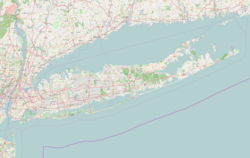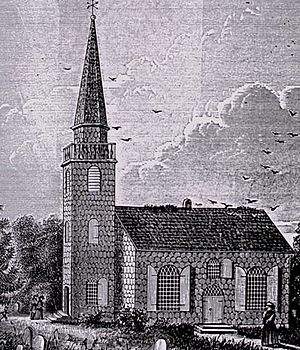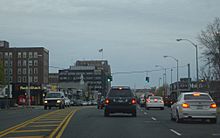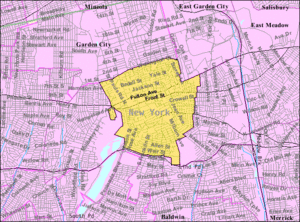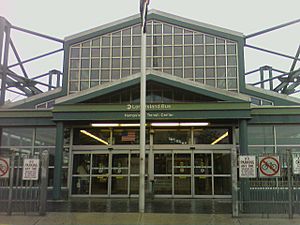Hempstead (village), New York facts for kids
Quick facts for kids
Hempstead, New York
|
||
|---|---|---|
|
Village and town seat
|
||
| Incorporated Village of Hempstead | ||
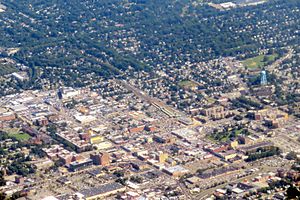
Hempstead in 2019, as seen from the air.
|
||
|
||
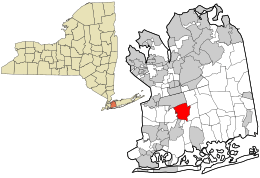
Location in Nassau County and the state of New York.
|
||
| Country | ||
| State | ||
| Region | Long Island | |
| County | ||
| Town | Town of Hempstead | |
| Settled | 1643 | |
| Incorporated | 1853 | |
| Named for | Heemstede, Netherlands | |
| Area | ||
| • Total | 3.69 sq mi (9.56 km2) | |
| • Land | 3.68 sq mi (9.54 km2) | |
| • Water | 0.01 sq mi (0.01 km2) | |
| Population
(2010)
|
||
| • Total | 53,891 | |
| • Estimate
(2019)
|
55,113 | |
| • Density | 14,960.10/sq mi (5,775.42/km2) | |
| Time zone | UTC-5 (EST) | |
| • Summer (DST) | UTC-4 (EDT) | |
| FIPS code | 36-33139 | |
Hempstead is a village located in the Town of Hempstead, Nassau County, New York, United States. The population was 53,891 at the 2010 census, but by 2019 had reached 55,113 according to the U.S. Census Bureau estimate. It is the most densely populated village in New York. Hempstead Village is the site of the seventeenth-century "town spot" from which English and Dutch settlers developed the Town of Hempstead, the Town of North Hempstead, and ultimately Nassau County. It is the largest community by population in both the Town of Hempstead and Nassau County.
Hofstra University is located in Hempstead.
Contents
History
Foundation
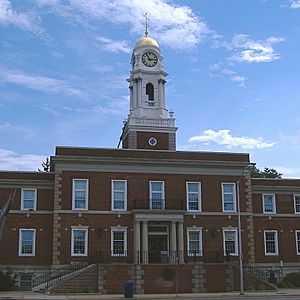
In the fall of 1643, Robert Fordham and John Carman crossed Long Island Sound by rowboat to negotiate with the local Indians for a tract of land upon which to establish a new community or "town spot". Representatives of the Marsapeague (Massapequa), Mericock (Merrick), Matinecock and Rekowake (Rockaway) tribes met with the two men at a site slightly west of the current Denton Green in Hempstead Village. Tackapousha who was the sachem (chief) of the Marsapeague was the spokesman for the other tribes. The Indians sold approximately 64,000 acres (260 km²), the present day towns of Hempstead and North Hempstead, for items worth less than $100 in today's market, although they were very valuable to the Native Americans in terms of the contemporary markets for European "trinkets," which held symbolic and spiritual importance to Native America peoples in the Northeast.
This transaction is depicted in a mural in Hempstead Village Hall, reproduced from a poster commemorating the 300th anniversary of Hempstead.
In the spring of 1644, thirty to forty families left Stamford, Connecticut, crossed Long Island Sound, landed in Hempstead Harbor and eventually made their way to the present site of the village of Hempstead where they began their English settlement within Dutch-controlled New Netherland. The settling of Hempstead marked the beginnings of the oldest English settlement in what is now Nassau County. Subsequent trips across the Sound brought more settlers who prepared a fort here for their mutual protection. These original Hempstead settlers were Puritans in search of a place where they could more freely express their particular brand of Protestantism. They established a Presbyterian church that is the oldest continually active Presbyterian congregation in the nation. In 1843, Benjamin F. Thompson wrote and published a history of the village, and an account of contemporary Hempstead Village. Thompson reported that there were 200 dwellings, and 1,400 residents; that the village was connected to New York City by a Turnpike and a railroad; that it had dry soil, excellent water, and pure air; and that it was the principal place of mercantile, and mechanical business, in the county. The village of Hempstead was incorporated on May 6, 1853, becoming the first community in Queens County (Nassau County did not exist as a separate county until 1899) to do so.
Regarding the origin of the name "Hempstead", Hempstead founder John Carman was born in 1606 in Hemel Hempstead, Hertfordshire, England, on ancestral land recorded in the 2nd historic census of England (under Edward the First), the Rotuli Hundredorum (Hundred Rolls) AD 1273 as being owned by his direct ancestor Henry Carman. These same properties were on record continuously as being owned by Henry's descendants, through John Carman of 1606. John's wife Florence and her father, Rev. Robert Fordham, were from the county of Surrey, England. Another theory regarding the origin of the name 'Hempstead' is that it is derived from the Dutch town of 'Heemstede' in the Netherlands, as this was an area from which many Dutch settlers of New Netherland originated. Several of Hempstead's original fifty patentees had Dutch surnames. In 1664, the new settlement adopted the Duke's Laws, an austere set of laws that became the basis upon which the laws of many colonies were to be founded. For a time, Hempstead became known as "Old Blue," as a result of the "Blue Laws".
Rise
As the years passed, the population of Hempstead increased, as did its importance and prestige. In 1703, St. George's Church received a silver communion service from England's Queen Anne. George Washington and other prominent leaders of the Revolution often stayed in Hempstead. Right after he became President, George Washington made a tour of Long Island, stopping overnight at Sammis Tavern here (Nehemiah Sammis's 1683 Inn). Hempstead can boast of its share of celebrities. Eleanor Roosevelt lived here for a time as did Lionel Barrymore. Eleanor Roosevelt, wife of former President Franklin Delano Roosevelt, spent her summers here during her teen years. Her family had a summer estate in Hempstead. Peter Cooper, inventor and politician, was a Hempstead resident. He married a local girl and settled here during the mid-19th century. Cooper ran for President on the "Greenback" ticket.
Charles A. Lindbergh, arguably the world's most famous aviator, spent quite a bit of time in Hempstead both before and after his epic solo flight from nearby Roosevelt Field to Le Bourget Field in Paris, France on May 20, 1927. While living here, Christopher Morley was so enamored with the place that on the three hundredth anniversary of its founding he wrote a beautiful essay in tribute. His first novel, Parnassus on Wheels, was written on a kitchen table at his Oak Street, Hempstead home in 1917. In 1704 the first stage coach on Long Island stopped to water its horses here.
During the American Revolution, Hempstead was a center of British sympathizers or Tories, as they were known. The British attempted to occupy Hempstead after the Battle of Long Island,and used St. George's as a headquarters as well as a place to worship. Judge Thomas Jones faulted a lax peace treaty for forcing the evacuation of the loyalists.
In March 1898, Camp Black was formed on the Hempstead Plains (roughly the shared location of Hempstead and Garden City), in support of the impending Spanish–American War. Camp Black was bounded on the north by Old Country Road, on the west by Clinton Road, and on the south by the Central Line rail. Camp Black was opened on April 29, 1898 as a training facility and a point of embarkation for troops.
In the 19th century Hempstead became increasingly important as a trading center for Long Island. In 1853 it became the first self-governing incorporated village. Many prominent families such as the Vanderbilts and the Belmonts built homes here, making Hempstead a center of Long Island society. Hempstead merchants established routes out to outlying farms, and served as a distribution point for many firms. Wagons would leave Hempstead loaded with tobacco, candy and cigarettes and return in a week to restock. Bakeries covered routes from Baldwin to Far Rockaway daily. Butchers ran routes to Seaford, Elmont, Valley Stream, Wantagh, East Meadow, Creedmoor, East Rockaway and Christian Hook. Drugs, medicines, perfumes, extracts, aprons, children's coats and dresses and men's clothes were peddled about the country by Hempstead merchants. People came from all sections of Queens to purchase stoves, and there were few places outside Hempstead where stoves could be purchased. Hempstead was Nassau County's shopping center for more than two centuries. Hempstead has historically been the center of commercial activity for the eastern counties of Long Island. In Nassau County, all major county roads emanate from this village. It is indeed the "Hub" of Nassau County. During the 18th and 19th centuries, all stage coaches en route to eastern Long Island from Brooklyn passed through Hempstead. Today, seventeen bus routes and three interstate buses leave from the village every day. In addition, the Hempstead Branch of the Long Island Rail Road has its terminal here. At one time, there were three railroad companies with terminals within the village.
Early Long Islanders made their living in agriculture or from the sea. Hempstead, with its central location, became the marketplace for the outlying rural farming communities. It was a natural progression, as the surrounding areas developed from small farms into today's suburbia, that Hempstead Village would remain as the marketplace. Chain department stores such as Arnold Constable and Abraham & Straus called Hempstead home for many years. Hempstead's Abraham & Straus was the largest grossing suburban department store in the country during the late 1960s. Hempstead was Nassau's retail center during the 1940s through the 1960s. The advent of regional shopping malls such as the one at nearby Roosevelt Field, the demise of nearby Mitchel Air Force Base in 1961 as well as the changing demographics put the retail trade in the village into a downward spiral that it was unable to recover from during the recessions of the 1970s and 1980s. A plethora of businesses left the village in the 1980s and early 1990s, notably retail giant, Abraham & Straus.
Recent years
In the course of the 1990s the village saw redevelopment as a government center as well as business center. There are more government employees from all levels of government in the village than there are in the county seat in Mineola. According to James York, the municipal historian, writing in 1998, the population during the day might rise to nearly 200,000, from a normal census of 50,000. Retailers' interest in the village was rekindled, due to the aggressive revitalization efforts of former Mayor James Garner, who served from 1989 to 2005, and former Community Development Agency Commissioner, Glen Spiritis, who served under Garner's administration. Specifically, two large tracts of retail property have recently undergone redevelopment. The former 8.8-acre (36,000 m2) Times Squares Stores (or TSS) property on Peninsula Boulevard and Franklin Street has been redeveloped as Hempstead Village Commons, a 100,000-square-foot (9,300 m2) retail center including Pep Boys and Staples. The former Abraham & Straus department store on 17 acres (69,000 m2) has recently undergone demolition and been replaced by a large retail development consisting of Home Depot, Old Navy, Stop & Shop and many other smaller establishments. A considerable infusion of state and federal funding as well as private investment have enabled the replacement of blighted storefronts, complete commercial building rehabilitations and the development of affordable housing for the local population. The replacement of the 1913 Long Island Rail Road Hempstead Terminal with a modern facility was completed in 2002 and a four-story, 112 unit building for senior housing, with retail on the ground level was completed at Main and West Columbia Streets in January 1998. Thirty two units of affordable townhouses known as Patterson Mews at Henry Street and Baldwin Road was completed and fully occupied in 1997.
In 1989, Hempstead residents elected James A. Garner (R) as their mayor. He was the first Black or African-American mayor ever elected to office in New York state and he served for four consecutive terms. The first African American male judge, Lance Clarke, was elected in 2001. Cynthia Diaz-Wilson was the first female justice in the Village of Hempstead and first African American village justice in the state of New York. Currently, Wayne Hall, a former Village of Hempstead trustee, serves as mayor. He was elected to office in 2005.
In recent years, there has been concern regarding ongoing gang activity in certain neighborhoods, notably the "Heights". Hempstead was also one of the first Long Island communities that had to deal with the Salvadoran gang, MS-13 or "La Mara Salvatrucha". The continual intra-violence this gang has exhibited has led to the formation of their arch-rivals, "SWP" or "Salvadorans with Pride". These issues have contributed to Hempstead's high crime rate as compared to other communities in the area.
Today
Hempstead has developed into the most populous village in the state of New York, with a population in excess of 50,000 people. It is also the seat of government for the town of Hempstead, the largest minor civil division in the nation with over seven hundred thousand people. Hempstead is just as urban (at least with regard to population density and activity) as any major city. In stark contrast to the surrounding villages in the town and county, it is more densely populated than many American cities with exception to New York City, Long Beach, New York, Mount Vernon, New York, Boston and Cambridge, Massachusetts, San Francisco, California, and Jersey City and Paterson, New Jersey.
Hempstead consists of several areas or neighborhoods that are distinct in character. Some enclaves have a reputation of being the source of crime, some are known to be populated by indigent residents, others consist of middle income residents and homeowners, while others boast stately homes with relatively little incidence of criminal activity. Originally, there were two known sides of town, "The Heights" (Hempstead Heights) and "The Hills" (Hempstead Hills). Hempstead Heights is the area east of Clinton St and west of Westbury Blvd. Over the years, several new regions, or "turfs" have informally been established, including "Terrace" (also known as "TA" or Terrace Ave.), "Parkside", "Trackside" and "Midway","D-Block".
There are over fifty religious institutions located in the village of Hempstead. They include a vast range of denominations, including, Roman Catholic,(Eastern Catholic) Episcopalian, Presbyterian, Orthodox, Methodist, Seventh-day Adventists, Baptist, Lutheran and other Christian churches, a Hindu temple, a Sikh Gurudwara, a Korean temple, a Hebrew Congregation and a host of smaller congregations.
Geography
According to the United States Census Bureau, the village has a total area of 3.7 square miles (9.5 km²), all land. The village of Hempstead differs from the Nassau County as it has a much more urban feel similar to the neighboring Queens County, New York.
Demographics
| Historical population | |||
|---|---|---|---|
| Census | Pop. | %± | |
| 1870 | 2,316 | — | |
| 1880 | 2,521 | 8.9% | |
| 1890 | 4,831 | 91.6% | |
| 1900 | 3,582 | −25.9% | |
| 1910 | 4,964 | 38.6% | |
| 1920 | 6,382 | 28.6% | |
| 1930 | 12,650 | 98.2% | |
| 1940 | 20,856 | 64.9% | |
| 1950 | 29,135 | 39.7% | |
| 1960 | 34,641 | 18.9% | |
| 1970 | 39,411 | 13.8% | |
| 1980 | 40,404 | 2.5% | |
| 1990 | 49,453 | 22.4% | |
| 2000 | 56,554 | 14.4% | |
| 2010 | 53,891 | −4.7% | |
| 2019 (est.) | 55,113 | 2.3% | |
| U.S. Decennial Census | |||
As of the census of 2010, there were 53,891 people, 15,234 households, and 10,945 families residing in the village. The racial makeup of the village was 21.9% White, 44.2% Hispanic, 48.3% Black or African American, 0.6% Native American, 1.4% Asian, 0.0% Pacific Islander, 22.8% from other races, and 5.0% from two or more races.
There were 16,034 households, out of which 38.7% had children under the age of 18 living with them, 39.0% were married couples living together, 27.0% had a female householder with no husband present, and 26.4% were non-families. 20.8% of all households were made up of individuals, and 6.7% had someone living alone who was 65 years of age or older. The average household size was 3.41 and the average family size was 3.76.
In the village, the population was spread out, with 26.2% under the age of 18, 16.3% from 18 to 24, 31.4% from 25 to 44, 17.5% from 45 to 64, and 8.5% who were 65 years of age or older. The median age was 29 years. For every 100 females, there were 91.6 males. For every 100 females age 18 and over, there were 86.4 males.
The median income for a household in the village was $45,234 and the median income for a family was $46,675. Males had a median income of $29,493 versus $27,507 for females. The per capita income for the village was $15,735. About 14.4% of families and 17.7% of the population were below the poverty line, including 20.7% of those under age 18 and 16.9% of those age 65 or over.
Points of interest
- Hofstra University
- Hofstra University Arboretum
- Hempstead Bus Terminal
- Nassau County African American Museum
- St. George's Episcopal Church
- Christ's First Presbyterian Church – First Presbyterian church established in the US
Transportation
The Rosa Parks Hempstead Transit Center is one of the largest hubs in Nassau County. It serves as the terminus of the Long Island Rail Road's Hempstead Branch, and is served by a number of Nassau Inter-County Express routes.
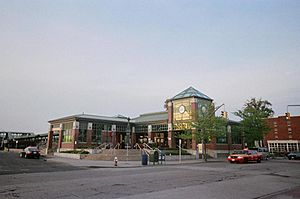
| Bus route
number |
Runs to / from | Notes |
| n6 |
|
|
|---|---|---|
| n6X | Express Service. | |
| n15 |
|
|
| n27 |
|
|
| n16 |
|
|
| n16X |
|
|
| n31 |
|
Via. West Broadway. |
| n32 |
|
Via. Central Avenue. |
| n35 | ||
| n40 | Via. North Main Street. | |
| n41 | Via. North Main St | |
| n48 |
|
Via. Carmans Road. |
| n49 |
|
Via. Newbridge Road. |
| n54 |
|
Via. Jerusalem Ave / Washington Ave. |
| n55 |
|
Via. Jerusalem Ave / Broadway. |
| n70 |
|
|
| n71 |
|
|
| n72 |
|
The Hempstead Wall of Fame
The 2005 Wall of Fame Inductees are:
|
The 2009 Wall of Fame Inductees are:
|
The Hempstead Wall of Fame is located in Kennedy Park off of Greenwich Street in Hempstead.
Education
Primary and secondary education
The community is served by the Hempstead Union Free School District. Students attend Alverta B. Gray-Schultz Middle School and Hempstead High School for their secondary years of K-12 education.
There is one private high school in Hempstead: Sacred Heart Academy, a private all-girls Catholic school.
Higher education
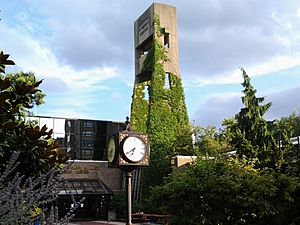
Hofstra University is in Hempstead.
Notable people
Residents (native or lived) about whom an article exists, by date of birth:
- Samuel L. Mitchill (1764–1831), physician, naturalist, and politic; born in Hempstead
- Walt Whitman (1819–1892; resident 1836–1838), poet, essayist, journalist, and humanist
- William S. Hofstra (1861–1932), entrepreneur
- Christopher Morley (1890–1957; resident during the 1910s), journalist, novelist, essayist, and poet
- Frank Field (b. 1923), television meteorologist
- John Mackey (1941–2011), NFL player
- Walter Hudson (1944–1991; life resident), 4th most obese human, Guinness World Record for the largest waist
- Julius Erving (born 1950), basketball star, lived in the village of Hempstead as a child for at least two or three years from around 1953 to 1955 or 1956
- Sheryl Lee Ralph (born 1956), actress and singer
- Eric "Vietnam" Sadler (born 1960; native 1960-87, music producer, Public Enemy, Ice Cube, Slick Rick, Bell Biv Devoe, Vanessa Williams)
- Rob Moore (born 1968; native), NFL football player
- Method Man (born 1971), rapper, songwriter, record producer, and actor; spent his childhood living between Hempstead and Staten Island
- Trevor Tahim "Busta Rhymes" Smith, Jr. (born 1972), resident, rapper, producer, and actor
- Prodigy (1974–2017; native), member of hip-hop duo Mobb Deep
- Craig "Speedy" Claxton (born 1978; native), NBA basketball player
- Tavorris Bell (born 1978), Harlem Globetrotter
- Scott Lipsky (born 1981), tennis player
- Hykiem Coney (1982–2006), anti-gang activist
- A+ (born 1982; native and childhood), rapper, made albums in 1996 and 1999 during his school years
- Roc Marciano (born 1978), rapper and producer
- Tu Holloway (born 1989), basketball player for Maccabi Rishon LeZion in the Israeli Basketball Premier League.
See also
 In Spanish: Hempstead (condado de Nassau, Nueva York) para niños
In Spanish: Hempstead (condado de Nassau, Nueva York) para niños



